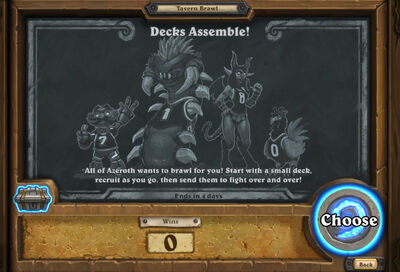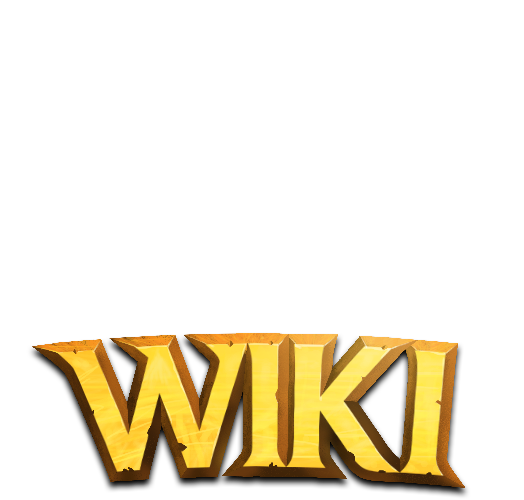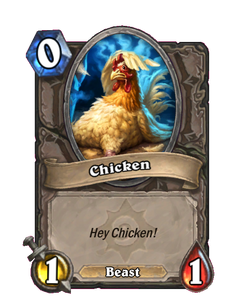
- "All of Azeroth wants to brawl for you! Start with a small deck, recruit as you go, then send them to fight over and over!"
Decks Assemble! is the twenty-fifth Tavern Brawl. It debuted on December 2, 2015. For exact times, see the schedule.
History
| Tavern Brawl | Start | End |
|---|---|---|
| 25 | December 2, 2015 | December 7, 2015 |
Overview
This complex Brawl sees players doing battle doing special decks generated during the match itself. This Brawl has no mulligan; instead, the player starts with a small hand and deck of certain preset cards. At the start of each turn, the player is able to Discover a random card; options may be neutral or matching the player's class, and may be of any type. Each time a player plays a card, a copy is shuffled into their deck. At the end of each turn, the player's hand is shuffled back into their deck, and a new selection of four cards are drawn.
Starting cards
Each player starts with a selection of the following cards in their deck and hand. As usual, the player going second also gains The Coin.
Notes
- Each player starts the Brawl with 4 cards in their hand, plus
The Coin for the player going second; and with 3, 4 or 5 cards in their deck. The varying numbers suggests the selection of cards is random.
- Playing a card will add a copy of that card to the player's deck. This takes place before Battlecries activate, which is significant for Joust minions, which have a chance to select their own copy for the Joust.
- There is one exception to the copying rule:
The Coin does not produce a copy, and so can only be used once. However, if the player does not play The Coin it will be shuffled into the player's deck as usual.
- It is possible that reaching 30 (or 60)[1] cards in the player's deck will cause this effect to cease activating.
- There is one exception to the copying rule:
- The player's hand is shuffled back into their deck before the new hand is selected. This means the player has a chance to draw any or all of the same cards again. This also means playing or not playing a card has no effect on the likelihood of drawing that card next turn. A possible exception may be if the player's deck becomes full.
- If the number of cards in your deck is smaller than 4, you will draw duplicates to complete your hand.[2]
- Decks, Assemble! uses a non-standard drawing mechanism. This means that
Burrowing Mine from
Iron Juggernaut will not activate when 'drawn',
The Mistcaller and
Chromaggus will not work, and so on.[3][4]
- It is reported that Jeeves will softlock the game if he tries to draw cards.[5][6]
Strategy
The result of the above rules means there is no reason for a player not to play all cards they wish to each turn, even if there is little value in doing so; since playing a card adds a copy to the player's deck, it is not possible to 'save' cards for later, and playing a card does not alter the likelihood of drawing it (or a copy) next turn.
While choice of card through the Discover effect at the start of each turn is important, choosing which cards to play is arguably even more impactful on future options. Each time a card is played, a copy is shuffled into the player's deck, essentially creating a never-ending supply of that card. Since minions persist, choosing to play a minion can allow the player to rapidly produce a series of copies of that card.
Cards chosen at the start of the turn are immediately available for play. However, remember that at the end of the turn they are shuffled back into the deck, with a relatively small chance of drawing them again next turn. This makes choosing cards which can be played that turn a more reliable tactic.
Discard effects can allow the player to tactically remove cards from their hand, preventing them from being drawn again next turn. This can shrink the pool of available cards, allowing the player to focus on desirable cards. Fel Reaver can perform a similar function for the player's deck, although at random.
While card draw effects work normally in this Brawl, with a fixed hand of 4 cards drawn at the start of each turn, the advantage is useful only for that turn; after that the extra card will be returned to the deck as usual. This also makes it very hard to overdraw due to a full hand.
Trivia
- The launch of this Brawl resulted in disconnections and extended downtime in the Europe region. With the developers working to restore service in the Europe region, the release of the Brawl in other regions appears to have been delayed until the issues can be remedied. With disruption of this kind following the release of Tavern Brawls becoming a regular occurrence, the incident spurred Blizzard to announce that they would be adding additional testing measures to help prevent this in the future.[7]
References
- ↑ Deck#Notes
- ↑ https://www.reddit.com/r/hearthstone/comments/3v7g5o/deathwing_every_turn/
- ↑ https://www.reddit.com/r/hearthstone/comments/3v771y/psa_the_mistcaller_battlecry_has_no_effect_in_the/
- ↑ https://www.reddit.com/r/hearthstone/comments/3v7fhi/how_iron_juggernaut_works_in_this_weeks_brawl/
- ↑ https://www.reddit.com/r/hearthstone/comments/3v7aju/psa_dont_pick_jeeves_in_the_new_tavern_brawl/
- ↑ https://www.reddit.com/r/hearthstone/comments/3v7emb/psa_do_not_play_jeeves_in_this_weeks_tavern_brawl/
- ↑ Official forums: Tavern Brawl and Stability Issues. (2015-12-02).




